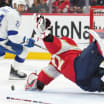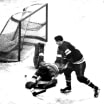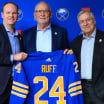Hasek looks back at trade to Sabres that changed NHL career, life
30 years later, Hall of Fame goalie discusses emergence in 'my second home'
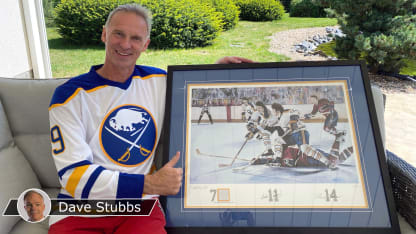
He had no idea that the ringing phone he hesitated to answer as he tied his shoes would dramatically change his NHL career, putting him on the path to iconic goaltending status and the Hockey Hall of Fame.
Phoning from across the Atlantic Ocean was Hasek's agent, Ritch Winter, to tell the veteran of 25 regular-season NHL games that he'd been traded by the Chicago Blackhawks to the Buffalo Sabres. Going the other way was goalie Stephane Beauregard and a fourth-round selection in the 1993 NHL Draft.
"I think it was 'Basic Instinct,' in English with Czech subtitles, but I can't be 100 percent sure," Hasek said last week by phone, speaking from his car near Prague. "To be honest, after that call I didn't pay much attention to the movie.
Watch: Youtube Video
"I think this trade completely, but not right away, changed my hockey career and my life, which of course is connected to my career. I didn't expect what was going to happen to me over the next few years in Buffalo."
What happened, of course, is that Hasek, without much delay, proved himself to be one of the greatest goalies in NHL history.
His story is even more remarkable in that he was selected in the 10th round (No. 199) of the 1983 NHL Draft by the Blackhawks.
Three decades after one of the most impactful trades in League history, the native of Pardubice, Czech Republic, says he had no idea that he was on the Sabres' radar, Buffalo's then-general manager Gerry Meehan saying at the time that he'd been working on a deal with Chicago for several months.
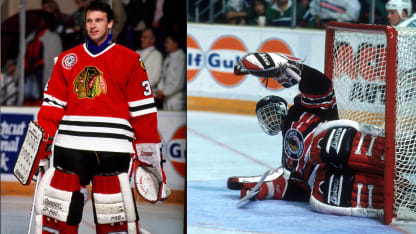
Dominik Hasek with the Chicago Blackhawks during the 1991-92 season. Paul Bereswill/Hockey Hall of Fame
"I had no idea about it, none at all," said the 57-year-old, who in Buffalo and beyond would become known as The Dominator. "I didn't read newspapers in Chicago because I didn't understand much English. I didn't hear any rumors. Later on, I found out that it was probably (coach) John Muckler and Gerry Meehan together who made this trade."
What cemented Hasek for the Sabres surely was the goalie's performance in Game 4 of the 1992 Stanley Cup Final against the Pittsburgh Penguins, sprawling, kicking and lunging over 53:27 in relief of Ed Belfour in a 6-5 loss in the final game of the Penguins sweep.
"I heard that my performance in the last game against Pittsburgh was something that really helped that trade to happen," Hasek said.
Chicago needed offense, and Blackhawks GM Mike Keenan coveted Sabres forward Christian Ruuttu. But the Sabres sent Ruuttu to the Winnipeg Jets for goalie Beauregard on June 15, 1992.
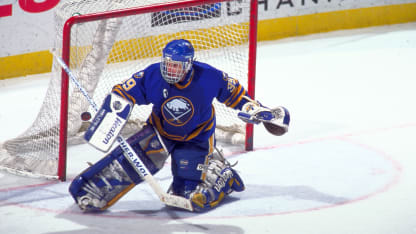
Dominik Hasek makes a blocker save for the Buffalo Sabres during the 1995-96 season. Paul Bereswill/Hockey Hall of Fame
The complex trade of Hasek would be completed nearly two months later, Beauregard shipped to the Blackhawks along with the pick that became forward Eric Daze. Chicago then traded Beauregard the Jets for Ruuttu on Aug. 10.
Essentially, the trade was Ruuttu to the Blackhawks for Hasek, the latter soon a Sabres cornerstone.
Hasek had a better sense of things 30 years ago than he had nine years earlier, his selection by the Blackhawks pretty much a mystery.
He recalls being in France on a 1983 summer exhibition tour, an 18-year-old playing for his club team, Tesla Pardubice, browsing magazines at a newsstand on an off-day with his friend and teammate Frantisek Musil.
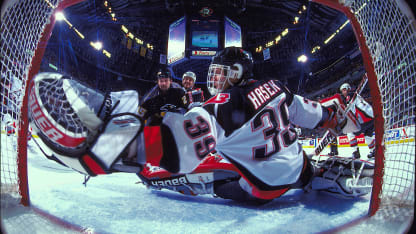
Dominik Hasek dives to catch a first-period shot against the Pittsburgh Penguins during a game in Buffalo on March 28, 1999. Dave Sandford/Hockey Hall of Fame
"'Frank' spoke English, but I didn't. I'd been studying Russian and German in school," Hasek said. "He picked up a copy of The Hockey News on the newsstand and discovered excitedly that he'd been drafted by the Minnesota North Stars (second round, No. 38). I said, 'Good for you!' and about 30 seconds later, he said, 'Dom, you were drafted, too!'
"I tell you the truth, I didn't care. He told me I'd been drafted by the Chicago Blackhawks, but it was nothing important to me. I didn't know what it meant. I was living a different life. There was no internet, no NHL information in the Czech papers like today.
"The world is different now. Back in 1983, I was a happy kid in my last year of high school, maybe I'd just finished, playing for the national men's team and junior national team. I didn't have a car but I had motorbike. It didn't go faster than 25 mph but I was living a happy life."

Dominik Hasek holds pucks of the Buffalo Sabres (left) and Czechoslovakia during a Hockey Hall of Fame Induction Weekend portrait session Nov. 17, 2014. Matthew Manor/Hockey Hall of Fame
Hasek remained in his native country until he made a huge, hesitant leap to the NHL at age 25, playing five games with the Blackhawks in 1990-91. His NHL debut Nov. 6, 1990, was a 28-save effort in a 1-1 tie at the Hartford Whalers.
He spent most of that season, and the one that followed, with Indianapolis of the International Hockey League, every day second-guessing his decision to come to North America. But in his 2014 Hall of Fame induction speech, Hasek said that his time with Indianapolis was invaluable, teaching him priceless lessons as a new pro.
He played 20 games with the Blackhawks in 1991-92, famously making 21 often acrobatic saves on 25 shots in Game 4 of the Final against the Penguins on June 1. That was Hasek's first action since a double-overtime loss to the St. Louis Blues in the first round April 22.
"It was the best thing that could happen to me," Hasek says now of the game against the Penguins and the trade that it spawned two months later. "I didn't expect how it would completely change my career but that's what happened within a few years. Sometimes there are things you don't think about too much that can change your life completely. That game against Pittsburgh was one of those things.
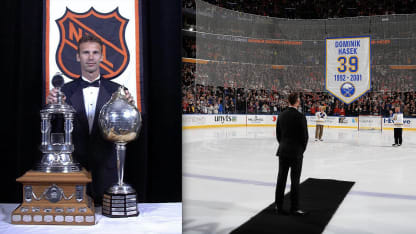
Dominik Hasek poses with the 1997-98 Vezina (left) and Hart trophies, and watches his No. 39 banner being raised to the rafters upon the retirement of his jersey Jan. 13, 2015 at First Niagara Center in Buffalo. Bruce Bennett (left), Getty Images; Bill Wippert/NHLI via Getty Images
"Buffalo was probably the best place for me. I liked the community. It's not a big city but the people there love hockey. It reminded me a little of Pardubice. Maybe Buffalo is not the biggest hockey city in the world, like New York or Chicago or Detroit or Montreal, let's say, but I think I was really suited for that place."
Hasek can remember the feeling of belonging in Buffalo like it was yesterday. Before his first training camp had even begun, the 1992-93 season workload to be shared almost evenly by Hasek, Grant Fuhr and Daren Puppa, veteran equipment manager Rip Simonick sat beside the newcomer from Chicago at the practice rink in Wheatfield, New York, and asked him which jersey number he preferred.
"That was a gesture I'll remember for the rest of my life," Hasek said. "It showed me that Buffalo really thought that I was their guy. It was the first time in my life that I was asked what number I wanted to wear."
Hasek chose the available No. 39 for deeply personal reasons. He had worn No. 9, an improbable number for a goalie, for nine years in the Czech Republic, given that jersey when a Tesla Pardubice defenseman was unable to play.

© Getty Images
Dominik Hasek of the Ottawa Senators makes a desperation save on Brian Gionta of the New Jersey Devils at Continental Airlines Arena in East Rutherford, New Jersey, on Feb. 1, 2006. Andy Marlin/Getty Images
"I'd worn No. 1 or No. 2, I don't remember, but I was 16 when they threw me No. 9 and they gave it to me again the next season, just because," he said. "I'd played well wearing No. 9 in the Czech Republic, so I wanted to keep a bit of that number. I told Rip to put a '3' before the '9' to bring something different to the NHL."
Hasek was the fifth and last Sabres player to wear 39, his sweater retired by the team Jan. 13, 2015. It came the year after his Hockey Hall of Fame induction and the retirement of his No. 9 by Tesla Pardubice.
Many of Hasek's career highlights were celebrated in Buffalo that night. In 1993-94, the second of his nine seasons with the Sabres, he went 30-20-6 to win the Vezina Trophy voted as the best goalie in the NHL, and the William M. Jennings Trophy (with Fuhr), awarded to the goalie(s) for the team with the fewest goals allowed. That was his first of six Vezina wins, all with the Sabres, and the first of his three Jennings wins -- he won it again with Buffalo in 2000-01 and once more with the Detroit Red Wings in 2007-08.
Hasek led the League with a 1.95 goals-against average that 1993-94 season and tied Belfour and Patrick Roy with an NHL-high seven shutouts.
He would also play a huge role in the Sabres going to the 1999 Stanley Cup Final against Dallas, the Stars winning in six games with Belfour, Hasek's stablemate in Chicago, in the champions' net.
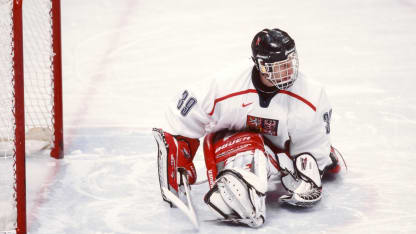
© Getty Images
Dominik Hasek of the Czech Republic warms up for the 1998 Nagano Olympic gold-medal game against Russia on Feb. 22, 1998. David Madison/Getty Images
"As a goalie, the most important thing for me was the feeling that the team believes in you," Hasek said. "The coaches, the organization, you feel that they believe in you, that you're their goalie. That season was defining, yes. Suddenly I started to feel that the organization believed that I was their guy.
"But I can't talk about one season that's my best. Most of my seasons were the best in my life, that's how I feel about my career. Winning the Stanley Cup twice with Detroit, having the best goals-against or save percentage, winning the Harts and Vezinas, whatever. That was a defining season, for sure, but I think it was just one of many great seasons I had."
His 1993-94 emergence was only his start in Buffalo. Hasek's six Vezina Trophy wins, in a span of eight seasons through 2000-01, are second only to the seven of pre-expansion icon Jacques Plante.
Hasek won the Hart Trophy, voted by members of the Professional Hockey Writers Association to the NHL most valuable player, in 1997 and 1998, the only goalie to win the award twice.
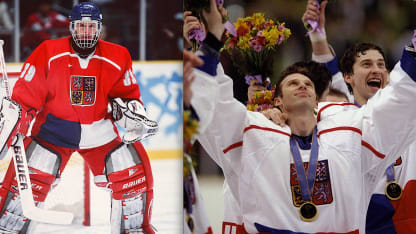
Dominik Hasek in goal for the Czech Republic during the 1998 Nagano Olympics, and celebrating his team's gold-medal victory. David Madison/Getty Images; Doug Pensinger/Allsport
In both of those seasons, he also was voted winner of the Lester B. Pearson Award (today the Ted Lindsay Award) as the MVP as chosen by members of the NHL Players' Association.
A trade would send him to the Red Wings on July 1, 2001, Hasek winning two Stanley Cup championships with them -- in 2002 and 2008 in his final season, having played one season with the Ottawa Senators in 2005-06 following a one-year retirement.
Hasek hung up his NHL pads with a record of 389-223-13 with 82 ties, a 2.20 goals-against average, .922 save percentage and 81 shutouts in 735 games. He led the League in save percentage six consecutive seasons (1993-94 through 1998-99).
In the Stanley Cup Playoffs, he was 65-49 with a 2.02 GAA, .925 save percentage and 14 shutouts.
And then there was anchoring his native Czech Republic to gold in the historic 1998 Nagano Olympics, the first time NHL players were invited to participate.
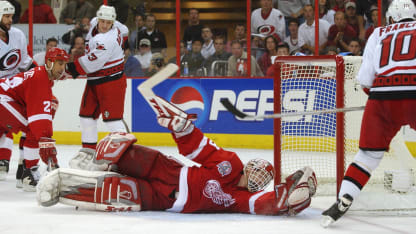
Detroit Red Wings' Dominik Hasek sprawls to make a save against the Carolina Hurricanes in Game 3 of the Stanley Cup Final on June 8, 2002. Hasek would win his first of two Stanley Cup championships with Detroit that season. Dave Sandford/Hockey Hall of Fame
"I'm done with goaltending," he said with a laugh, having played two more seasons in Europe after his NHL career. "I'm happy to play defense in my beer league."
Hasek's NHL achievements are mind-boggling:
He holds the Sabres career records for shutouts (55), save percentage (.926, minimum 100 games) and goals-against average (2.22, minimum 100 games), and ranks second in wins (234) behind Ryan Miller (284).
His 389 NHL wins are the second most by a Europe-born goalie, behind Henrik Lundqvist (459).
During his nine seasons with Buffalo, Hasek led all NHL goalies in save percentage and shutouts (minimum 50 games played).
And he is the only goalie drafted in the 10th round or later to reach 300 wins.
All of that, and his international play representing the Czech Republic -- playing in four Olympics, three Canada Cup tournaments, five IIHF World Championships and two World Junior Championships -- earned him induction into the IIHF Hall of Fame in 2015.
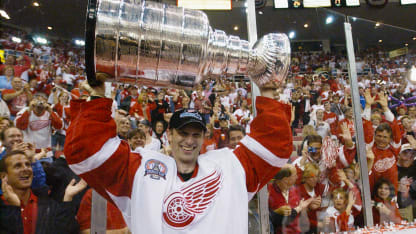
Dominik Hasek celebrates with the Stanley Cup after the Detroit Red Wings defeated the Carolina Hurricanes in Game 5 of the 2002 Stanley Cup Final on June 13, 2002, at Joe Louis Arena in Detroit. Elsa/Getty Images/NHLI
It is all quilted into the tapestry of a brilliant athlete who had no idea that the 30th anniversary of his life-changing trade to Buffalo was at hand until he took a call in his car last week.
"I very much appreciate the reminder but honestly, I live in the present, not in the past," said Hasek, who has virtually all of his important hockey memorabilia not displayed in his home but in the Czech Hockey Hall of Fame in Prague, on loan to the shrine.
But Hasek does speak with enormous respect of two frames that hang on his walls: an autographed painting of the Sabres' famed "French Connection" line of Gilbert Perreault, Richard Martin and Rene Robert, and a photo of Red Wings legends Gordie Howe and Steve Yzerman, sitting together on Detroit's bench.
"I bought that one of Gordie and Stevie because they're great guys," Hasek said. "I had a chance to meet Gordie many times and Stevie was my captain in Detroit.

Dominik Hasek onstage at Microsoft Theater in Los Angeles on Jan. 27, 2017. Hasek was chosen among the 100 Greatest NHL Players as part of the League's Centennial year celebrations. Dave Sandford/NHLI via Getty Images
"I decided to buy this picture because I admire them, as I admire the French Connection, just as I remember all the people in Buffalo who helped me, who were part of my success for nine years -- management, teammates, the fans."
In 2001, he established Hasek's Heroes, a hockey program for underprivileged youth in Buffalo and the broader area, strengthened a decade later when it was partnered with the Buffalo Sabres Foundation.
"I feel my connection to Buffalo even more because of the hockey program, because it's continuing," said Hasek, who returns to the city at least once a year to check on the program and ensure its operation.
He grew pensive as he considered a world that is larger than hockey, a 40-minute conversation having brought him closer to his career and his driveway.
"If something happens in Europe, and we know what the situation is in Ukraine, well …" Hasek said, the thought unfinished. "I want to be positive, but you know what's going on there and you never know what could happen later on.
"I know that I have a place to go to if I feel in danger. Buffalo is the place I would go back to, always. It's my second home."
Top photo: courtesy of Dominik Hasek




